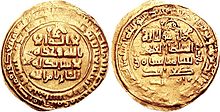图赫里勒·贝格
| 图赫里勒 | |||||
|---|---|---|---|---|---|
 图赫里勒发行的硬币 | |||||
| 塞尔柱帝国苏丹 | |||||
| 统治 | 1037–1063 | ||||
| 前任 | 无(帝国建立者) | ||||
| 继任 | 阿尔普·阿尔斯兰 | ||||
| 出生 | 990年 | ||||
| 逝世 | 1063年9月4日 | ||||
| 配偶 | 阿卡 (优素福·卡迪尔汗之女) 阿勒敦江可敦 赛叶德·法蒂玛 | ||||
| 子嗣 | 无 | ||||
| |||||
| 王朝 | 塞尔柱王朝 | ||||
| 父亲 | 米哈伊尔·贝格 | ||||
| 母亲 | ? | ||||
| 宗教信仰 | 逊尼派 | ||||



图赫里勒·贝格(土耳其语:Tuğrul,土库曼语:Togrul beg,波斯语:طغرلبیگ。有时亦拼写为Toghrul I、Tugril、Toghril、Tugrul或Toghrïl Beg等。990年—1063年9月4日),又译为图格鲁勒·贝格、脱斡邻勒·伯、吐格利尔拜格等,是塞尔柱帝国的建立者,1037年-1063年间在位。他将大欧亚草原上的土库曼(乌古斯人)联合起来,组成了一个将共同祖先追溯至塞尔柱的部族联盟,带领他们征服了伊朗东部。
青年时期
[编辑]公元990年,图格鲁勒·贝格作为米哈伊尔·贝格的长子(“图赫里勒”(toɣrïl/toɣrul)在古突厥语中为“猛禽”的意思,可能是凤头苍鹰。在早期突厥历史和文化中,至少在回鹘时期起就作为人名使用[1])乌古斯叶护国重臣塞尔柱·贝格的长孙出世,由于其父亲早逝,他与弟弟恰格勒·贝格由祖父扶养成人。
1009年,祖父塞尔柱过世,图格鲁勒的叔叔伊斯拉里接下部落长老职位。
1016年,图格鲁勒随部族一同南下伊朗高原,随着年纪增长,他在部族中发言权日渐上升。
1021年,塞尔柱一族卷入喀喇汗国的继承战争,站在阿里特勤一方,与加兹尼苏丹马哈茂德为敌。后者设宴捉拿伊斯拉里与其子库塔尔米什下狱,31岁的图格鲁勒接手长老一职,正式开始领导部落。
部族之长
[编辑]1025年,图格鲁勒与弟弟恰格勒为协助阿里特勤,率领部族进军波斯呼罗珊省,对抗加兹尼王族穆哈马德的攻击。
1029年,贝格兄弟与阿里特勤发生争执,同盟关系紧张,不过加兹尼王国此时也陷入内战,因此双方未进一步冲突。
1030年,图格鲁勒向赢得内战的新苏丹马苏德一世提议释放伊斯拉里父子,被马苏德回绝。
1032年,达布西耶之战爆发,贝格兄弟再次出兵协助阿里特勤,击败加兹尼的花剌子模总督阿尔屯塔什,两军在互有损失的状况下签订协议各自退兵回国。同年,伊斯拉里在加兹尼城的狱中逝世。
1035年,沙赫·马立克在花剌子模击败贝格兄弟,南逃的兄弟档向旧敌马苏德一世求援,苏丹断然拒绝并派遣贝脱迪领军攻打,结果加兹尼军大败、指挥官被俘,马苏德一世不得不释放俘虏,割让拿沙(Nasa)、法拉瓦(Farava)、大益等地给塞尔柱部族,并正式承认他们为雇佣兵。
1037年,图格鲁勒叛变自封为苏丹,并于隔年攻下加兹尼重镇内沙布尔[2] [3]。
1040年,冲突再启,贝格兄弟在丹丹纳干战役重创加兹尼军队,获得了呼罗珊及花剌子模等区域的广阔领土[4][5]。
帝国苏丹
[编辑]1055年,图格鲁勒从白益王朝手中夺回阿巴斯王朝的首都巴格达,被阿巴斯哈里发卡伊姆一世正式封为苏丹,建立塞尔柱苏丹国。图赫里勒视哈里发为傀儡,手握帝国的控制实权,与弟弟恰格勒将帝国分为东、西两半实施共治[6]。信仰伊斯兰教逊尼派的图赫里勒在位期间以统一伊斯兰世界为目标,主要与什叶派的法蒂玛王朝及东正教拜占庭帝国军作战,帝国各地的原住民在接下来的几十年中受到游牧民文化影响,在宗教、语言以及风俗上大量突厥化,原先的主流阿拉伯文化为突厥及波斯文化所取代[7][8]。
在行政制度上,塞尔柱大量起用波斯当地的豪族,试图运行古帝国遗留的行政机关,甚至在追溯王朝起源时尝试与波斯建立联系[9],巴列维语(中古波斯语)亦在帝国统治的西亚、中亚地区传播[10]。
1063年,图格鲁勒过世,由于其膝下无子嗣,伊斯拉里之子库塔尔米什与恰格勒之子阿尔普·阿尔斯兰同时起兵,为争夺继承权爆发了达姆甘之战。
资料来源
[编辑]- ^ Laszlo Rasonyi; Imre Baski. Onomasticon Turcicum: Turkic Personal Names, vol.2. Sinor Research Institute of Inner Asian Studies. 2007.01.15: 758–759. ISBN 978-0933070561.
- ^ C.E. Bosworth, The Ghaznavids: 994-1040, (Edinburgh University Press, 1963), 242.
- ^ Francis Robinson( 法兰西斯·鲁宾逊 ). 劍橋插圖伊斯蘭世界史. 黄中宪译. 台湾: 如果出版社. 2008. ISBN 9789866702198.
- ^ Tony Jaques, Dictionary of Battles and Sieges: F-O, (Greenwood Publishing Group, 2007), 476.
- ^ O.Özgündenli, "Persian Manuscripts in Ottoman and Modern Turkish Libraries", Encyclopaedia Iranica, Online Edition, (LINK (页面存档备份,存于互联网档案馆))
- ^ Gibbon, Edward(爱德华·吉朋). 羅馬帝國衰亡史. 席代岳译. 台湾: 联经出版公司. 2004. ISBN 957-08-2771-8.
- ^ Encyclopædia Britannica, "Seljuq", Online Edition, (LINK (页面存档备份,存于互联网档案馆)): "... Because the Turkish Seljuqs had no Islamic tradition or strong literary heritage of their own, they adopted the cultural language of their Persian instructors in Islam. Literary Persian thus spread to the whole of Iran, and the Arabic language disappeared in that country except in works of religious scholarship ..."
- ^ M. Ravandi, "The Seljuq court at Konya and the Persianisation of Anatolian Cities", in Mesogeios (Mediterranean Studies), vol. 25–6 (2005), pp. 157–69
- ^ M.A. Amir-Moezzi, "Shahrbanu", Encyclopaedia Iranica, Online Edition, (LINK (页面存档备份,存于互联网档案馆)): "... here one might bear in mind that Turco-Persian dynasties such as the Ghaznavids, Saljuqs and Ilkhanids were rapidly to adopt the Persian language and have their origins traced back to the ancient kings of Persia rather than to Turkish heroes or Muslim saints ..."
- ^ F. Daftary, Sectarian and National Movements in Iran, Khorasan, and Trasoxania during Umayyad and Early Abbasid Times, in History of Civilizations of Central Asia, Vol 4, pt. 1; edited by M.S. Asimov and C.E. Bosworth; UNESCO Publishing, Institute of Ismaili Studies: "... Not only did the inhabitants of Khurasan not succumb to the language of the nomadic invaders, but they imposed their own tongue on them. The region could even assimilate the Turkic Ghaznavids and Seljuks (eleventh and twelfth centuries), the Timurids (fourteenth–fifteenth centuries), and the Qajars (nineteenth–twentieth centuries) ..."
延伸阅读
[编辑]- Bosworth, C. E. The early Ghaznavids. Frye, R. N. (编). The Cambridge History of Iran, Volume 4: From the Arab Invasion to the Saljuqs. Cambridge: Cambridge University Press. 1975: 162–198 [2020-01-23]. ISBN 0-521-20093-8. (原始内容存档于2020-02-04).
- Bosworth, C. E. The Political and Dynastic History of the Iranian World (A.D. 1000–1217). Frye, R. N. (编). The Cambridge History of Iran, Volume 5: The Saljuq and Mongol periods. Cambridge: Cambridge University Press. 1968: 1–202 [2020-01-23]. ISBN 0-521-06936-X. (原始内容存档于2018-04-04).
- Bosworth, C. E. Iran under the Buyids. Frye, R. N. (编). The Cambridge History of Iran, Volume 4: From the Arab Invasion to the Saljuqs. Cambridge: Cambridge University Press. 1975: 250–305 [2020-01-23]. ISBN 0-521-20093-8. (原始内容存档于2020-02-04).
- Madelung, W. The Minor Dynasties of Northern Iran. Frye, R. N. (编). The Cambridge History of Iran, Volume 4: From the Arab Invasion to the Saljuqs. Cambridge: Cambridge University Press. 1975: 198–249 [2020-01-23]. ISBN 978-0-521-20093-6. (原始内容存档于2020-06-14).
- Minorsky, V. Tabriz. The Encyclopaedia of Islam. Brill. 2000.
- Van Donzel, E. J. (编). Islamic Desk Reference. E.J. Brill. 1994.
图赫里勒·贝格 出生于:990年逝世于:1063年9月4日
| ||
|---|---|---|
| 统治者头衔 | ||
| 前任者: 伊斯拉里 |
塞尔柱部族长老 1021年-1037年 |
继任者: 无(王朝建立) |
| 前任者: 无(王朝建立) |
塞尔柱帝国苏丹 1037年-1063年 |
继任者: 阿尔普·阿尔斯兰 |
